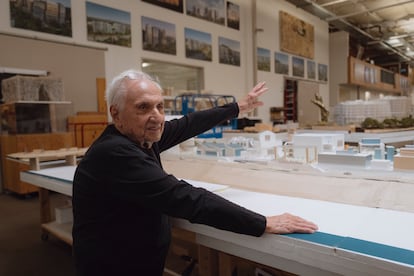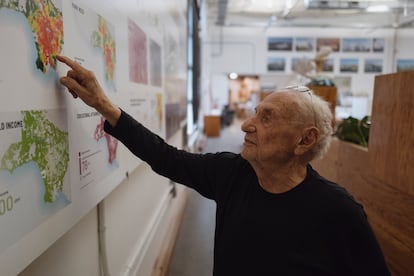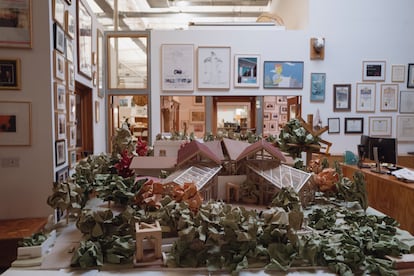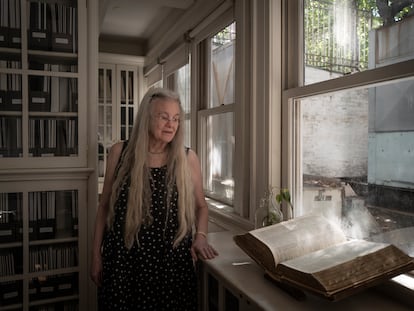Frank Gehry, architect: ‘I was always told that I wasn’t the same as everyone else, but some people made fun of that’
The 94-year-old architect receives EL PAÍS at his offices in Los Angeles to talk about his career and his new projects


In 1943, magnate Howard Hughes built a huge hangar for the Spruce Goose, the gigantic wooden plane that took off only once three years later. The businessman chose Playa Vista, a community west of Los Angeles, near the Pacific Ocean, for this project. A few feet away was another industrial space: a BMW research center.
For the past 23 years, this site has housed Frank Gehry’s offices. The 94-year-old architect works in a space filled with natural light. There are dozens of models of his projects, which have made him one of the most recognized artists in the world. He stops in front of a map of Los Angeles hanging on a wall. He points to an area colored with a dense red.
“This is a neighborhood where children live 10 years less than average because they don’t have parks,” he points out. “It’s a public health map. It’s all red with problems, but no one gives a damn. Even if we kick and scream…”

The area is called South Gate and it’s seven miles south of Los Angeles. And, on the day of his interview, Gehry is happy. After seven years of waiting, the Los Angeles County Board of Supervisors has just approved his project to transform the area with a cultural center, in partnership with Venezuelan conductor Gustavo Dudamel. “It’ll have a 500-seat concert hall, a yoga room, a movie theater, art galleries... it’ll be on a single street near the Los Angeles River. It’s incredible, I still can’t believe it will be reality,” he sighs.
Gehry highlights that they’ve allowed him to recover parts of the areas that lie near the river. This will result in the creation of 16 hectares of green areas in a Latino-majority community with poverty rates that top 13%. “With $800 million, I can do it. And all those children will be able to have a little more life. It sounds like a lot of money, but I’m sure that healthcare costs [the government] more,” he notes.
Gehry is the son of a violinist of Polish origin and a boxer father who made a living driving trucks. The family left Toronto for the United States in 1947. “Those days put some reality in my life,” he says. “I worked as a truck driver for four or five years until I started night school. There, I took a ceramics class with a professor who was building a house designed by Raphael Soriano. When he invited me to the construction site, he saw that I was very excited to see the cranes that were erecting the steel. So, he put me in an architecture class.”
In 1989, at the age of 60, Gehry received architecture’s highest honor: the Pritzker Prize. In their statement, the jury mentioned the controversial nature of the work of the adopted Californian. “I didn’t know [my work] was controversial. I used corrugated metal and cyclonic mesh because they were cheap materials. I had to work with these materials because they were used all over the world,” Gehry shrugs. He remembers a visit to a fence factory where he saw how it took four people and one machine just one hour to make enough mesh to cover the stretch from downtown Los Angeles to the beach.
The Guggenheim Museum in Bilbao was a turning point for the architect, as it changed the face and dynamics of the Spanish city with a building. “We didn’t know we were doing that, of course,” he confesses. He affirms that, since its construction, the museum has offered Bilbao residents “billions of dollars” in tourist revenue.
Part of his memory is occupied by the criticism he has received throughout his career. “I was always told that I wasn’t the same as others, but there were people who made fun of that,” he admits. From his time in the Basque Country, he remembers the attacks made by the artist Jorge Oteiza, who considered the project a “real soap opera” and something “typical of Disney.”
“He put up a sign that said ‘kill the American architect,’” he recalls. “Then, I met him. We became very good friends, because he realized that I was like him. I was an artist looking for ways to express ideas with inert materials.” Gehry says that Oteiza gave him a work of art. He keeps it in his private office, on the upper floor of the building.

Gehry — dressed in jeans and a black T-shirt — speaks to EL PAÍS in a spacious room whose walls are covered with drawings, paintings and photographs with musicians such as Herbie Hancock and Yo-Yo Ma, artists like Robert Raushenberg and celebrities like Princess Diana and Barack Obama. The 44th American president gave him the Medal of Freedom in 2016, one of the highest civilian honors in the United States. Hockey, another of the architect’s great passions, covers a good part of the office lobby.
At the back of the immense space, there’s a television that’s updated every day with an image of the construction of the Guggenheim Museum in Abu Dhabi. The Bilbao museum was delivered on time in 1997. On the other hand, its brother in the East has suffered all manner of delays. Work began in 2011, but was suspended due to the Arab Spring uprisings. The pause was then extended because of concerns about the conditions of the workers. Then, the pandemic arrived. The museum will finally open its doors in 2025.
When asked how he stays motivated to fulfill his vision, Gehry replies: “I don’t have any other choice. If I have a project, I [need to follow] my talents and my way of thinking… even if it’s stupid.”
With his good humor, Gehry hides the fact that he’s always willing to put up a good fight in order to move projects forward. At times, he cannot hide the frustration caused by some current clients. Meaghan Lloyd, the head of the office, intervenes in the conversation. “Let’s not talk about it, Frank,” Lloyd calms him, redirecting the conversation to good memories from the past.
The Walt Disney Concert Hall in Los Angeles turns 20 in 2023. The building remains one of the most emblematic places in downtown. But before its construction began in 1992, Gehry was the subject of a tense dispute with the company’s board, which wanted to control how the work was carried out. “The auditorium had plush seats, carpets and chandeliers. It seemed like a very expensive place. They were very comfortable with that. They wanted to enter the room and see a crystal chandelier, bronze railings, precious woods and leather seats. They thought that I — [since I] like to work with laminated wood — was going to force them to use cheap materials, when that wasn’t the case at all. I’m intelligent enough to know that an auditorium must look good, imposing and important,” he scoffs.

The board made adjustments to Gehry’s project, causing an increase in costs of between $50 million and $100 million. “It was money that they threw away because of their presumptions. And there was nothing you could do to convince them that they were wrong. They were lemmings going [into the fire] to prove that they were right. Instead, it became clear that they were stupid and wrong. I didn’t have to say anything, it was obvious,” he explains. The end of the dispute came when Diane Disney — Walt and Lilly’s daughter — conditioned the use of $25 million from the family inheritance to be utilized as the architect had originally intended.
This past October, the Los Angeles Philharmonic dedicated a tribute to Gehry. In addition to having built the temple that serves as the orchestra’s headquarters, he’s become an influential patron of the organization. He’s a close friend of Gustavo Dudamel, who affectionately calls him “Pancho Pistolas” — a nickname from his college years at USC. He’s also close to the Venezuelan’s predecessors on the conductor’s podium: the Finnish Esa-Pekka Salonen and the Indian Zubin Mehta.
The night he was honored, Dudamel chose Claude Debussy’s La Mer to close the musical programme. It was a nod to two creators who blew up the conventions of their disciplines to become masters.
Sign up for our weekly newsletter to get more English-language news coverage from EL PAÍS USA Edition
Tu suscripción se está usando en otro dispositivo
¿Quieres añadir otro usuario a tu suscripción?
Si continúas leyendo en este dispositivo, no se podrá leer en el otro.
FlechaTu suscripción se está usando en otro dispositivo y solo puedes acceder a EL PAÍS desde un dispositivo a la vez.
Si quieres compartir tu cuenta, cambia tu suscripción a la modalidad Premium, así podrás añadir otro usuario. Cada uno accederá con su propia cuenta de email, lo que os permitirá personalizar vuestra experiencia en EL PAÍS.
¿Tienes una suscripción de empresa? Accede aquí para contratar más cuentas.
En el caso de no saber quién está usando tu cuenta, te recomendamos cambiar tu contraseña aquí.
Si decides continuar compartiendo tu cuenta, este mensaje se mostrará en tu dispositivo y en el de la otra persona que está usando tu cuenta de forma indefinida, afectando a tu experiencia de lectura. Puedes consultar aquí los términos y condiciones de la suscripción digital.
More information
Archived In
Últimas noticias
The Florida Keys tourist paradise is besieged by immigration agents: ‘We’ve never seen anything like this’
The latest scam on WhatsApp behind the legal dream: using immigration status as bait
Oil, gold and rare earth elements: the backdrop to US political tension with Venezuela
The open war against the oil ‘phantom fleet’
Most viewed
- Families demand repatriation of bodies of Colombians who died in Ukraine: ‘This war is a slaughterhouse for foreigners’
- The low-cost creative revolution: How technology is making art accessible to everyone
- Liset Menéndez de la Prida, neuroscientist: ‘It’s not normal to constantly seek pleasure; it’s important to be bored, to be calm’
- Christian Louboutin: ‘Young people don’t want to be like their parents. And if their parents wear sneakers, they’re going to look for something else’
- ‘El Limones’ and the growing union disguise of Mexican organized crime










































